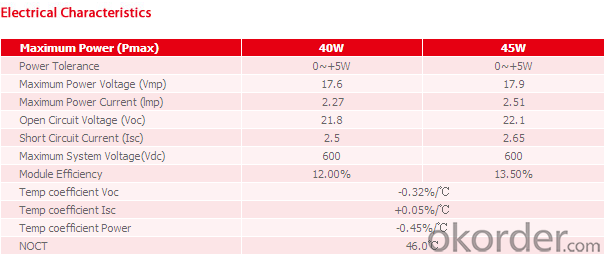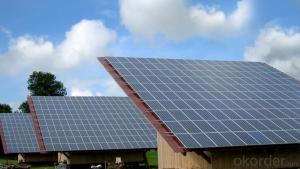Off-grid Solar Panel TDB125×125/2-36-P Reliable
- Loading Port:
- Ningbo
- Payment Terms:
- TT OR LC
- Min Order Qty:
- 100 carton
- Supply Capability:
- 10000 carton/month
OKorder Service Pledge
OKorder Financial Service
You Might Also Like
Specification:
· Highest performance enabled by higher efficiency monocrystal line cells and the latest Solar Wafer Technology for multicrystal line cells
· Lower weight design which reduces the total system load on a roof, making it ideal for residential customers. Its shape allows for better roof utilization
· Its low weight means easier handling for installers
· Modules are designed to withstand PID (Potential Induced Degradation)*
· High light transmission Anti-Reflective Glass with improved self-cleaning capability
· 0/+5 W Positive power tolerance for reliable power output

Warranty
CNBM Solar provides one of the most comprehensive module warranties in the industry:
· 10 years for product defects in materials and workmanship
· First 12 years for 90% of warranted minimum power
· Remaining 25 years for 80% of warranted minimum power
Certification
CNBM Solar strictly carries out the ISO 9001 quality control methodology and has implemented check points at every step of the production process to ensure our product performance durability and safety. The stringent quality control process has been confirmed by numerous independent agencies and LDK Solar modules earned IEC, TUV and UL certifications.
· IEC:IEC 61215, IEC 61730 (1&2), conformity to CE
· UL 1703 2002/03/15 Ed:3 Rev:2004/06/30
· ULC/ORD-C1703-01 Second Edition 2001/01/01
· UL and Canadian Standard for Safety Flat-Plate
· ISO 9001: 2008 Quality Management Systems
· CEC Listed: Modules are eligible for California Rebates
· PV Cycle: Voluntary module take back and recycling program
· MCS Certificate



FAQ
1. How do I decide which system is right for me ?
For protection from long outages, include a generator or solar panels in your Must solar system. Shorter outages can be handled by a battery-only system.
2. Where my system will be installed ?
Must solar systems are usually wall-mounted near a home's main electrical (circuit breaker) panel.
3. How do I install my system ?
A must solar backup inverter is connected to a home electric system , we will supply detailed installation manual and videos for our customers .
How fast will my system respond to a power outage ?
Must solar inverters typically transfer to battery power in less than 16 milliseconds (less than 1/50th of a second).
What kind of batteries do the systems include ?
Must solar backup electric systems use special high-quality electric storage batteries.
- Q:Can solar panels be installed on golf courses or recreational facilities?
- Yes, solar panels can be installed on golf courses or recreational facilities. These locations often have vast open spaces with ample sunlight, making them ideal for harnessing solar energy. Additionally, installing solar panels in these areas can help offset the energy demands of the facilities, reduce carbon emissions, and promote sustainability.
- Q:I am interested in solar energy, but am not sure how eficiant it would be in the northwest? Any comments would be apriciated.
- If you have southern exposure . Go for it.
- Q:Can solar panels be used in areas with high levels of shade or obstruction?
- Solar panels can still be used in areas with high levels of shade or obstruction, but their efficiency and performance may be significantly reduced. Shade or obstructions like tall buildings, trees, or nearby structures can block sunlight, preventing the panels from receiving the necessary amount of light to generate optimal electricity. However, there are advanced technologies and design techniques available that can mitigate the impact of shading, such as using micro-inverters, optimizers, or tilting and positioning the panels to maximize sunlight exposure. Overall, while solar panels can still function in shaded areas, it is crucial to assess the level of shading and its potential impact on energy production before installation.
- Q:i want to join multiple solar panels into a bank so i only need one length of wire, i am going to use diodes to stop them sending power back into the one before it. is this ok or do i need something else?
- Check out some of the videos on YouTube on this subject.
- Q:right now, you would need a suitable number of solar panels just to power house that can take up a lot of real estate. so my question is, is it feasible to create something that absorbs more of the suns energy like a magnet it would suck it up. the point of doing this would be so that we wouldnt need so much space so many panels just to power home for example.i hope thats coherent.
- No, it's not possible to make solar panels that suck in photons like a magnet. In current physics, the only way to do that would be to make a near-black-hole-like structure that sucks photons in due to its high gravity. Not only would that be prohibitively expensive and currently technologically impossible, it would destroy its surrounding area. Edit: idlenesss - My whole point is that increasing the photons-per-area is currently impossible, and that's what the question was about.
- Q:Hi there. I live in Colorado, and we obviously get a ton of snow there. I im looking into a solar power system for my home, and I am wondering if the snow will accumulate on the panels, or if, because of the energy passing through, it will melt on contact? By the way we get about 20' of snow each year, and it comes on often. I will also be putting them on my roof. Thanks for your help.
- Good news and not so good news. You need to be able to access the panels to clean the snow off. There is not any heat generated other than the heat of the sun hitting the black colour - which would amount to some melting ability during a sunny day - but it isn't sunny when it snows! Apparently, solar panels work better in the cold and where snow can reflect light so to increase the amount of light - photons - hitting the panel.
- Q:Can solar panels be installed on community buildings?
- Yes, solar panels can be installed on community buildings. In fact, community buildings like schools, libraries, and community centers are excellent candidates for solar panel installations as they often have large roofs or open spaces that can accommodate solar arrays. Installing solar panels on community buildings not only helps reduce electricity costs but also promotes sustainability and clean energy in the community.
- Q:Can solar panels work in the shade?
- They will work somewhat in the shade but they really work best in direct sunlight. I have solar panels on my home and just a cloud passing over will cause the output to drop quite a bit.
- Q:Can solar panels be installed on a school or educational institution?
- Yes, solar panels can be installed on a school or educational institution. In fact, many schools around the world are increasingly adopting solar energy systems as a sustainable and cost-effective solution to meet their energy needs. Installing solar panels on educational institutions not only helps reduce their carbon footprint but also serves as an educational tool, allowing students to learn about renewable energy and environmental conservation firsthand.
- Q:Can solar panels be installed on walls?
- Yes, solar panels can be installed on walls. However, it is important to consider the orientation and angle of the wall to ensure maximum sunlight exposure for efficient energy generation. Additionally, the strength and stability of the wall should be evaluated to support the weight of the solar panels.
1. Manufacturer Overview |
|
|---|---|
| Location | |
| Year Established | |
| Annual Output Value | |
| Main Markets | |
| Company Certifications | |
2. Manufacturer Certificates |
|
|---|---|
| a) Certification Name | |
| Range | |
| Reference | |
| Validity Period | |
3. Manufacturer Capability |
|
|---|---|
| a)Trade Capacity | |
| Nearest Port | |
| Export Percentage | |
| No.of Employees in Trade Department | |
| Language Spoken: | |
| b)Factory Information | |
| Factory Size: | |
| No. of Production Lines | |
| Contract Manufacturing | |
| Product Price Range | |
Send your message to us
Off-grid Solar Panel TDB125×125/2-36-P Reliable
- Loading Port:
- Ningbo
- Payment Terms:
- TT OR LC
- Min Order Qty:
- 100 carton
- Supply Capability:
- 10000 carton/month
OKorder Service Pledge
OKorder Financial Service
Similar products
New products
Hot products
Hot Searches
Related keywords





























